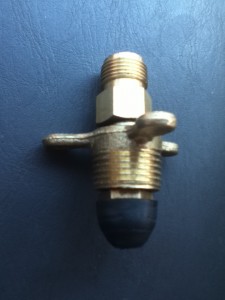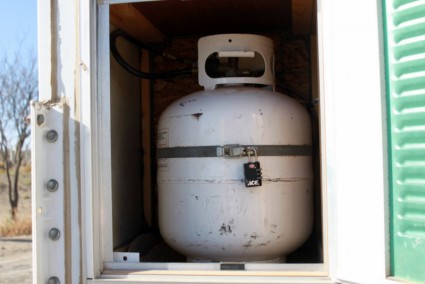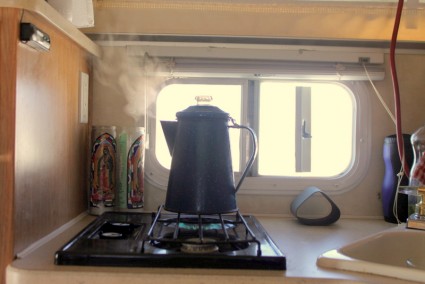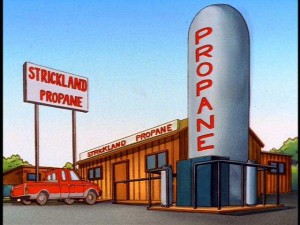Editors Note: this is part four of a ten part series we are doing on overlanding advice. Future PanAm overlanders this is for you. They post each Sunday.
Propane was a difficult subject to gather good information on (second only to Malaria medication). Because we had such little information we were never sure if we could get propane at any given plant or any given country. In retrospect this was a mistake as most plants were able to fill up our cylinder. Only in Argentina did we need a special $5 brass adapter, and even then, many plants in Argentina have their own adapter for US bottles.
We have one removable propane cylinder; the standard edition US 20 pound white tank that will only hold 80% of capacity before it trips the overflow protection device (OPD). Therefore actual capacity is only 16 pounds. It is worth seeking out a cylinder with this valve (OPD) as some Latin American plants will only fill your tank if it is equipped with this safety device.
Side Note: With more space and less weight concerns (not the advantages of the lightweight pop-up set-up), we would have brought an extra 10 or 20 pound propane tank. If only for simple stress management.
Different Types of Tanks and Cylinders
Many of the larger overland campers have a fixed tank. We have heard it can be easier to fill fixed tanks in some countries, but in most countries it is more difficult. There is a lot of information for fixed tanks online and not much about the removable cylinders. This becomes confusing as both types have different filling methods and are both often referred to simply as tanks. Our information here refers only to removable cylinders.
Each country in the Americas has not only a different fill valve, but different shapes and sizes. The US valve, size, and height are unique to the US. It is possible to purchase a new tank for each country, but storing the propane would be a hassle due to the changing sizes and a new fitting or adapter would need to be installed with each tank change.
Side Note: Carry an outdoor camping grill/burner. Wood or coal are prime for an evening steak but a mountain morning with coffee, bacon, and eggs is best done on propane. This way you will always have a (light weight) back up to cook your food. Not to mention, cooking outdoors is part of the good life.
Oddly the one pound green or Coleman-style tank seems to be universal. From Costa Rica to Peru we were able to find these with relative frequency. Often at a price premium however, so it doesn’t seem prudent to plan on these as your primary source.
I would consider purchasing an adapter so you can occasionally run your propane system off of these small Coleman tanks as a back up. That way an empty propane tank doesn’t take you away from a groundswell that has just moved in on the remote Pavones surf break (ask me how I know).
Butane versus Propane
From the Mexican border south, butane not propane is the gas of choice. In warmer climates they use butane because the vapor pressure is much lower. To complicate things the term “propano” in Latin America is used to mean either propane, butane or a mix. We haven‘t come across an RV or camper propane system that won‘t accept butane interchangeably, but if you‘re worried ask your manufacturer. We have had no trouble running butane for cooking, heating, or powering our Dometic 3-way refrigerator. It’s also worth mentioning here, we had no problems with gas quality.
The disadvantage of butane is it’s intolerance of lower tempuratures. It won’t flow in sub freezing temperatures due to a lack of pressure. It certainly won’t cut it in Yukon deep freeze territory. We encountered freezing temperatures in both Bolivia and Peru. Because of the umbrella terminology we are not sure if they filled us up with butane or propane in these countries. We guess it was indeed butane or a mix; regardless we had no issues with our tank or lines.
Finding a Propane Station
Unlike the US, you will need to go to a propane plant to fill your cylinder. Gas stations are never equipped to fill cylinders as the exchange method is highly preferred all over Latin America. Convenience stores and the like may advertise propane, but we found this was just for exchanging an empty cylinder for a full one.
Not to fear, filling stations can be found on the outskirts of nearly any urban area. Locating them is often a challenge as they are, without fail, in the industrial sections of town where tourist maps don’t reach. Many overlanders such as ourselves have included these plants in our camping lists with GPS coordinates. This is doubly helpful as it aids your search for the plant and lets you know they’ve filled foreign cylinders in the past.
We were able to walk up to plants not listed on previous camping lists with success. However, you might be turned away if the person you are dealing with has never seen a foreign propane bottle. With a lack of know how, they may turn you away despite having a plethora of adaptors at their disposal. In popular overlanding areas such as Mexico or Cusco Peru, they’ll know right away what to do.
Measuring Propane Level
I messed up in this department. Our camper was not fitted with a propane level monitor so our monitor was me taking off the tank once a month and making a wild guess as to how much propane remained while I shook it. I would highly recommend international overlanders equip their propane system with a gauge or at a minimum carry a hand-held spring scale to measure the remaining weight (the maximum fill weight and tare weight are printed on the bottle).
Propane Use
Propane use varies greatly. We talked to some that require fill-ups monthly and a couple in an RTT whose 10 pound cylinder regularly lasted three months. To give you a general idea, we could go two months on one fill of our 20 pound cylinder. While bush camping on the Bolivian altiplano our tank lasted only three weeks while we ran our heater often, cooked every meal, and powered our fridge with gas. In Colombia and Ecuador we ate out often and our tank lasted nearly 3 months.
Side Note: If you have a propane fridge like us, there is little leniency. Once you’re empty you must get propane immediately, plug-in, or leave your food to spoil.
The Jumper Method
We never had the need to employ this method and chances are you won’t either. However having the equipment at your disposal to make it happen might be insurance for the prepared.
Here is a write-up (and other great info) on how to complete this procedure with relative safety.
If you’re equipped and well-versed in this method, filling your tank in the remotest of villages will now be an option. It would be worth practicing as, chances are, when you need it there won’t be internet to access instruction or a specialty hardware store to purchase the part you need.

























































Thanks for this! We’re traveling with a Chilean camper and we’ve found it impossible to get a Chilean cylinder filled in Peru. From what I read, we might have less trouble filling a Peruvian one in Ecuador…